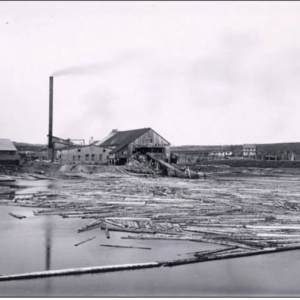 The Curtis family sawmill is an important piece in the history of Springdale. The family play an important role in Little Bay’s history as well. The histories of the two communities are intertwined as I’ll consider here.
The Curtis family sawmill is an important piece in the history of Springdale. The family play an important role in Little Bay’s history as well. The histories of the two communities are intertwined as I’ll consider here.
The Curtis family is primarily represented in Little Bay by Francis Edward. He was the son of an Englishman named William Curtis. The family had immigrated to the Twillingate region from Dorset, England in the mid 19th century. Francis was born in Durrell, Notre Dame Bay on November, 11th in 1840. My earliest reference to Francis Curtis in Little Bay is found on the 1882 voter’s list which places his home at Loading Wharf. I suspect an earlier arrival, however, as he had obtained the rank of Mine Overseer by the time of his marriage to Louisa Taverner there in 1884.
By this time his brother John Curtis had purchased the saw mill on Mill Island in Wolf’s Cove. Wolf’s Cove would become the town of Springdale and the history of that town is predacated on the presence of sawmills. During the time of Little Bay mine’s boom the Curtis family sawmill is noted in reference to Little Bay. In the early years the development of Springdale occurred to service Little Bay, this is why following the loss of Little Bay we witness a reduction in Springdale’s population. The loss of Little Bay’s population was greater, however, and following the 1904 fire Springdale takes over the role of the region’s commercial and economic hub.
Fire was an ongoing threat to the area. The summer of 1881 witnessed one of the more devastating fires to engulfed the region. Defence and recovery of this fire was aided greatly by the visiting Captain Kennedy and the crew of his ship the HMS Druid. Newspaper coverage of this event thanked the efforts of both William Kennedy and Mine Manager Adolph Guzman. Due to this fire John Curtis suffered the loss of much of his property. His sawmill was damaged but his home and furniture were completely lost. How this is reported is noteworthy for a couple of reasons. For one, the loss of furniture is mentioned separately from the home itself. This is relevant as seen in coverage of the 1888 fire. The practice at the time upon incoming fire was to remove all possible furniture from the home and submerge it in water or bury it underground for recovery later. The loss of home and furniture, therefore, was much more devastating than the loss of the home itself which was easier to replace. The other reason the wording is important is in noting that the sawmill itself was not lost. He’d likely concentrated his efforts on the sawmill at the time as oppose to his home. In coverage of the 1904 fire which destroyed much of both Springdale and Little Bay we see that saving the sawmill was of vital importance. This is because with the sawmill they retained the ability to produce the wood necessary to aid recovery of the town as most of what was lost needed to be rebuilt with wood.
I only have one reference giving Francis Curtis the rank of Mine Overseer. I know from an entry in Constable Wells’ diary that the title can be used interchangeably with “boss of the mine” and I know it is different from the higher rank of Mine Manager. I’m fairly certain that an Overseer found underground is the same rank as Mine Captain. However, I suspect the men found in charge of other areas such as the loading wharf and jigging mill could also be referred to as Overseers. I know there are multiple Mine Captains at a time from references to McVicar and multiple Overseers from Kennedy’s notes on the differences in wages due the different positions. I wonder therefore if Francis Curtis being an Overseer while living at Loading Wharf indicates something more akin to a shipping and receiving or dock’s manager. I also wonder if Francis Curtis held the position of Mine Overseer in part because of his connection to the logging industry. The timing of his reference at that rank corresponds with the presence of Mine Manager Wallace and Wallace was notorious for such nepotism. The mine had a great need for regularly supplied logs and their supply could be hindered by both flooding and drought as log driving was done by way of water. The sawmill operation was further under constant threat by fire and often held up in legal disputes.
The exact departure date of Francis Curtis from Little Bay is difficult to gauge. It occurs between 1885 when his infant son dies there and 1889 when his name is absent from the voter’s list. However, I think an earlier date more likely. I know that reference to the sawmill and its operations start referring to “the Curtis brothers” together in 1885. The pair are involved in a series of legal battles going forward from this point that involve the ownership of logs. There is one with the blacksmith William Ross and another with Simon Routledge, a lumberman from Nova Scotia. This is perhaps best put in context with reference to their application for 43 square miles of land situated between Indian Brook and the Exploits River in 1887. In a letter to the editor of the Twillingate Sun it is said that “these two men are bent on preventing all other people from bringing any lumber out of that part of the forest land whose right it is” which demonstrates at least some public hostility toward their operations existed.
In 1890 a visiting minister noted that the recent departure of John Curtis and his family from Wolf’s Cove had negatively impacted the church. It had been their home where visiting clergy had previously stayed. Mrs. Curtis had greatly aided the Sunday School. The choir had even sounded better with the Curtis’ there. John had recently moved the lot to Twillingate. His brother may have remained in charge of the sawmill operation as Francis and his family are found living on Mill Island in 1891 with the birth of their daughter Ivy there that year. The following year, in 1892, the Curtis sawmill succumbed to fire and was finally lost. Afterward Francis moved to Pilley’s Island where he worked as a millwright until his death there in 1908. His wife Louisa returned to Springdale afterward where she lived with her daughter Ivy until her death in 1940. According to information found at the Springdale Heritage Centre as submitted by Stella Marie (Rideout) Gosse – the Curtis home was located on the current site of Dalfen’s Mall.
I should point out that the image I’ve included is of Botwood. It was found on the Heritage NL site. I hope you’ll forgive a little creative license with its inclusion here. I used it as I couldn’t find one for a 19th century Springdale sawmill and it just seemed like the right fit for the topic. If you’re looking for old photos of Springdale there are many featured on The Rooms website where the town is currently their highlighted community. You can also find an impressive collection of resources at the Springdale Heritage Centre which will soon be opening for their summer operating hours. I’ve been so far unable to find any pictures for this Curtis family – if you possess photos of those I’ve mentioned please reach out via the FB page. It could also help in locating them if you shared this article with any Curtis’ you know. You’ll find my sources for this family below. Thanks for reading!
Sources:
- 1881, July – John Curtis (owner of a saw mill) lost his home and furniture to a fire (HGS / TS)
- 1882 – Francis Curtis living at Loading Wharf, Little Bay (Voter’s List)
- 1884 – Marriage of Francis Edward Curtis (widower and mine overseer) to Louisa Susanna Tavisner (Vital stats)
- 1885 – The blacksmith William Ross vs the Curtis brothers over possession of logs (Supreme Court docs)
- 1885, April – Death of infant Wilfred Clarence Reginald Curtis son of Francis Curtis and Louisa Tavener (UC burials)
- 1887 – Complaint regarding John and Francis Curtis application for rights to 43 square miles of land between Indian Brook and the Exploits River (TS)
- 1887, Sept – J. Curtis and F. Curtis involved in lengthy legal battle with Mr. Routledge (TS)
- 1888, July – The Curtis brothers are unable to access their logs due to a lack of rain water (TS)
- 1889, Jan – John Curtis had a handsome schooner built at Mill Island (TS)
- 1889, July – John Curtis launched his new schooner and set sail for St. John’s (TS)
- 1889, Sept – Mr. Curtis went north on the Conscript (TS)
- 1889, Oct – Mr. Curtis arrived on the steamship Conscript from the south (TS)
- 1889 – Curtis name absent from Little Bay’s voter’s list
- 1890, April – During missionary meetings it was noted that the absence of the Mr. J Curtis and his family was felt. They had recently moved from Wolf Cove to Twillingate (TS)
- 1890, July – Mr. Curtis suffered a loss of many logs due to high water (TS)
- 1891 – Birth of Francis and Louisa’s daughter Ivy Clarice at Mill Island (Springdale heritage centre)
- 1892, Aug – Saw mill belonging to Curtis and Clarke destroyed by fire (TS)
- 1902, Feb – Francis Curtis listed as millwright at Pilley’s Island (Marriage of his daughter Aileen May)
- 1908, June – Death of Francis Edward Curtis at Pilley’s Island (Headstone)
